Haworthia is a genus containing around 57 species from the Asphodelaceae family. These succulent plants are small, forming rosettes of chunky leaves. They don’t tend to have much of a stem and they form clumps. Plants in this genus are very similar, but their leaves can show wide variation, even within a single species. They enjoy well-draining, gritty soil and full sun to partial shade. If growing as a houseplant, place on a bright windowsill and water infrequently when the soil has thoroughly dried out.
Haworthia flowers are small, tubular and double-tipped, often with the petals bending backwards away from the flower throat, this is termed reflexes. Flowering takes place during the summer months: from a central stem an inflorescence comes out bearing small flowers almost white (or with pink or brown veins) with six tepals (the union of sepals and petals) arranged on a single axis of symmetry. Here are some of the common types of Haworthia plants:
- Haworthia glauca
- Haworthia Obtusa
- Haworthia angustifolia
- Haworthia mirabilias
- Haworthia truncata
- Haworthia cooperi
- Haworthia pumila
- Haworthia mutica
- Haworthia Limifolia Spider White
- Haworthia attenuata
- Haworthia fasciata
- Haworthia bolusii
- Haworthia cuspidata
- Haworthia margaritifera
- Haworthia chloracantha
- Haworthia nigra
- Haworthia emelyae
- Haworthia viscosa
- Haworthia reinwardtii
- Haworthia marumiana
- Haworthia coarctata
- Haworthia Longiana
- Haworthia springbokvlakensis
- Haworthia cymbiformis
Haworthia glauca
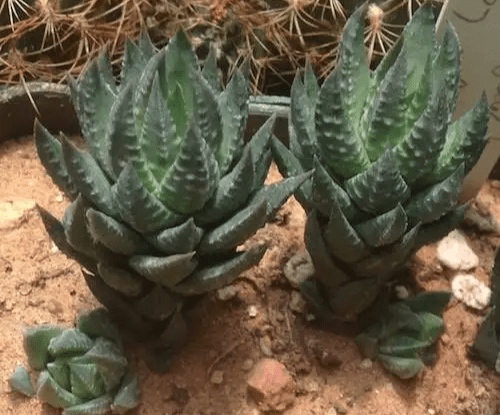
Haworthia glauca grows solitary but in age can branch from the base and form clumps. The rosette can reach up to 8 cm in diameter. The stem is erect and densely packed with pointed leaves. The leaves are thick, lanceolate, triangular at the apex, curved inwards, glaucous green in color; the tips are darker and pointed. Blooming occurs from late spring to late summer. The flowers are tubular, small, whitish, borne at the apex of the stem. The inflorescence can reach up to 30 cm in height. The plant can turn on reddish hues during the rest period. The specific epithet “glauca” means “cerulean” and refers the color of the leaves. Haworthias generally resemble small aloes, but they differ in size and the distinctive inflorescence.
Haworthia Obtusa

Haworthia Obtusa is a small-sized succulent and often reaches up to only three to four inches in height. Its leaves form a compact, dense rosette that is approximately six inches across in diameter in an adult plants. The stems of Obtusa succulents are thick and fleshy. Its leaves are also thick with rounded edges and tips. This is because the stems and leaves of Haworthia are meant to store water for dry periods. Each leaf is fresh green in color with pockets on top. These pockets are used by the plant for storing water. When in bloom, Haworthia Obtusa produces small flowers that are white with either pinkish or greenish undertones. These beautiful flowers will be a great addition to your home or garden.
Also Read: Different Types of Succulents For Your Home Garden
Haworthia angustifolla
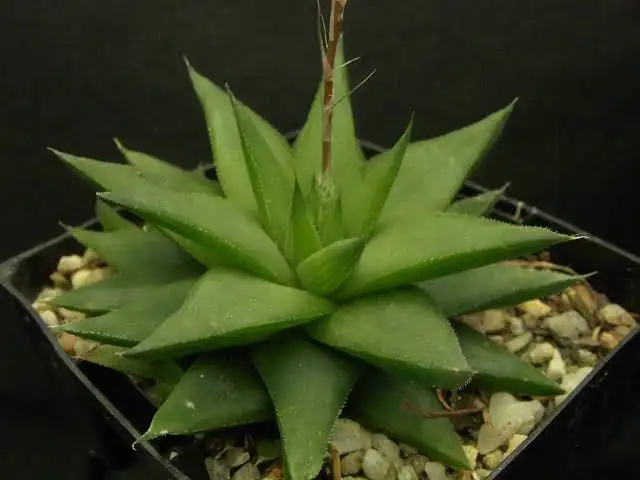
Haworthia angustifolla is a modest species forming tiny light green rosettes with long narrow upturned leaves. This species is closely allied and frequently confused with Haworthia chloracantha, but it is a softer species and the marginal teeth are smaller and more closely spaced. Haworthia angustifolia can be very easily propagated by offsetts. They are of easy cultivation and relatively low maintenance, which makes them a good houseplant.
Haworthia mirabilias
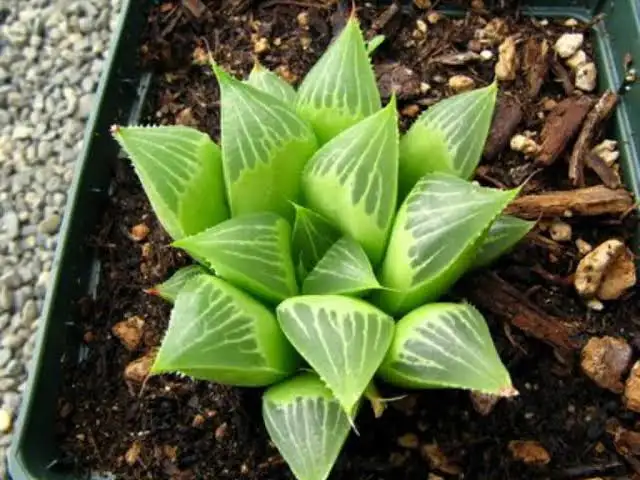
Haworthia mirabilias is a succulent evergreen slow-growing species reaching a size of 4 to 45 centimetres in height. It is usually a solitary stemless plant. The leaves are green, with longitudinal pale green lines along the upper surfaces and small teeth along the margins. They turn to brownish or reddish in the sun. The leaves form a rosette and the flowers are white and small, in an inflorescence. This highly variable species is one of the “retuse” species of Haworthia, meaning that it usually grows sunken beneath the ground with its flattened leaves only showing on the surface.
Haworthia truncata

Haworthia truncata is a miniature leaf succulent with flattened ends and shallow roots. The top surface gives the impression of having been cut or truncated, hence the name truncata. The leaves are covered in white or grey lines with varicosities. In nature the plants are often half-buried, with only the tips of the leaves visible above the soil. The truncated tip is translucent, allowing light to enter for photosynthesis. In this respect, the species resembles Lithops, Fenestraria, and Haworthia cymbiformis. This species produces small, white, tubular flowers on slim, upright stems.
Haworthia cooperi

Haworthia cooperi is a slow growing succulent. It produces small clumps of fleshy, bluish green to light green rosettes. The leaves are variably patterned with translucent stripes at the tips called fenestrations. This structure is an adaptation to the harsh light conditions in its native habitat. In some varieties, the whole leaves can become transparent. The leaves may also be tapering towards the tip, bristled, or completely round and smooth. Although mainly grown for its attractive fleshy leaves, H. cooperi can bloom in spring through summer, producing a simple inflorescence of white flowers.
Haworthia pumila

Haworthia pumila is one of the largest succulents of its kind. The plant can reach up to 15 cm in diameter and 25 cm in height. The succulent is stemless and forms a rosette of leaves. The leaves are long, triangular-ovate, dark green in color, covered with white round tubercles. Blooming occurs from late spring to early summer. The inflorescence is 40 cm tall. The flowers are tubular, greenish to brownish-white in colour and waxy in texture. The seeds ripen in autumn. The plants live for about 30 to 40 years if they are cultivated properly.
Also Read: Different Types of Euphorbia Plants For Your Home
Haworthia mutica
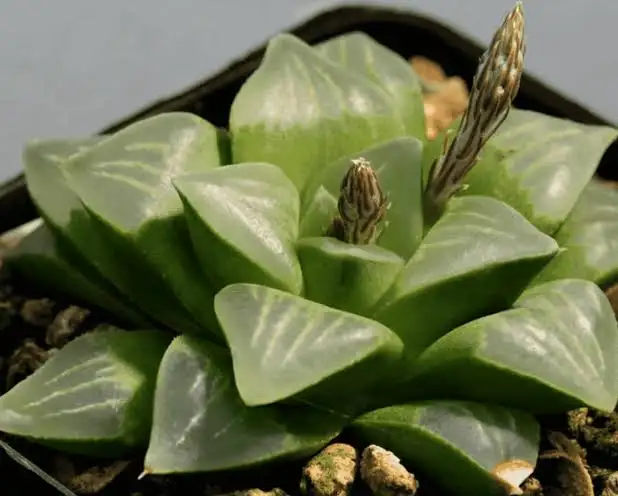
Haworthia mutica is a charming succulent plant grows in clumps, is stemless and forms a rosette of leaves that can reach up to 8 cm in diameter. The leaves are thick, truncated, triangular at the apex, dark green in color; the tips are transparent and act like windows, allowing sun to enter inside of the leaf for chlorophyll processing. Blooming occurs from late spring to late summer. The flowers are tubular, small, white greenish in colour with purplish stripes. The plant can turn on reddish hues depending on radiation.
Haworthia Limifolia Spider White
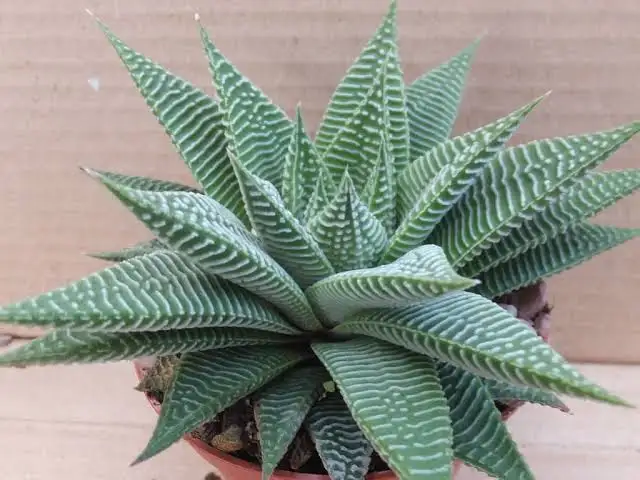
Haworthia Limifolia Spider White is a small succulent plant forming rosettes of triangular, fleshy leaves, that reach 8-9 centimeters in diameter and 6 centimeters in height. It’s also called “Fairy washboard”, for the peculiar, rough surface of its leaves: if you run a fingertip along them, you will feel the roughness of their raised, white bands. Leaves are in fact bright green, triangular, sharply pointed and striped in these white, prominent bands. Flowers are similar to the ones of the regular form. They are borne in groups of 15-20 on a 35 centimeters long inflorescence, and are small, usually white, more or less tinged in pink or adorned with brown veins, equipped with six tepals.
Haworthia attenuata

Haworthia attenuata is an evergreen succulent plant with short leaves arranged in rosettes. The succulent leaves are tapered (“attenuata” means “tapering”) and have bands of white tubercles on them. The species subdivides and offsets readily; in the wild it forms large clumps. It is popular as a house plant, due to its resistance to drought and general hardiness. It is frequently confused with the rarer Haworthia fasciata, to which it looks very similar. However Haworthia attenuata can easily be distinguished by its white tubercles, which occur on both upper and lower sides of its leaves (H. fasciata has tubercles only on the underside, with a smooth upper surface of its leaves).
Also Read: Different Types of Aloe Vera Plants
Haworthia fasciata
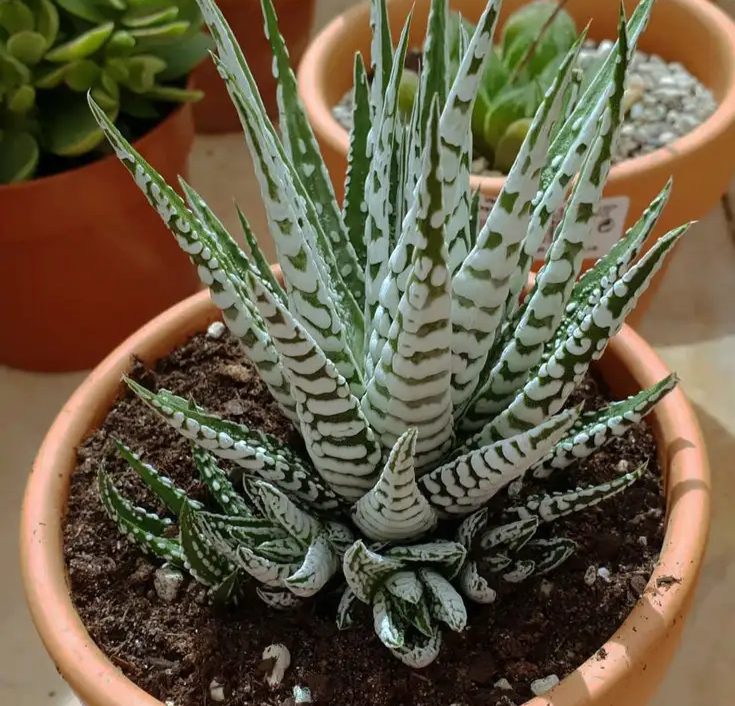
Haworthia fasciata also referred to as Zebra Plant, is a diminutive plant, it has rosettes of thick fleshy leaves which have raised white ridges on the undersides giving the plant its popular common name. The upper surfaces of the leaves have small whitish tubercles. In summer, a long flower-stem is produced on which are borne tiny jewel-like white flowers with central green stripes. The scape is so long it quickly arches over, usually lying horizontally alongside the plant. Primarily they are grown in gardens. However, they are also grown in greenhouses, conservatories and within homes.
Haworthia bolusii

The name of this beautiful succulent that was originally described by John Gilbert Baker in 1880 in honor of Harry Bolus, a famous South African botanist and collector of succulents. It is a beautiful succulent, consisting of the typical narrow and compact rosette shape of lanceolate, pointed and upward-facing leaves, whose epidermis is pleasantly covered with longitudinal lines.
The beautiful emerald green of the foliage contrasts nicely with the real highlight of H. bolusii: along the leaves emerges soft whitish bristles, twisted and almost curled, which wrap the plant, giving the impression of a kind of delicate white spider web. At the end of spring, pleasant light flowers with brownish veins bloom at the apex of long stems.
Also Read: Different Types of String Succulents
Haworthia Cuspidata

Haworthia Cuspidata is commonly known as the ‘Star Window Plant’. This succulent is considered a cross between the Haworthia retusa and Haworthia cymbiformis species. It is one of the most elegant species of the genus, characterized by graceful rosettes with fleshy foliage of a lively lime green color, very bright, enriched by small translucent areas, that make the light pass trough, and allow the plant to survive very well, even in conditions of low light (hence the common name of “star window plant”), making it a succulent particularly suitable for indoor environments.
The small leaves have the shape of a wedge – a characteristic that gave them the name of ‘cuspidata’, from Latin – “pointed”. It is a strong and resistant plant, which occupies little space and does not present difficulties in cultivation. Perhaps not many know, that the leaves inside them are full of aloe juice, commonly used to treat skin irritations, as well as, in alternative medicine.
Haworthia Margaritifera

The largest member of the genus Haworthia, Haworthia Margaritifera looks like an aloe due to its relatively large rosettes of spotted, pointed leaves. It grows from a fleshy, fibrous root system and slowly creates a cluster of plants in a pointy, mounded clump. The plump, long, pointed leaves that emerge from the centre of the rosette are rigid and succulent. Each leaf is bright to olive-green, while on the outer side of the leaves, hundreds of greenish-white bumps (tubercles) decorate the surface, making them look ornately spotted.
Haworthia chloracantha

In its natural habitat, it grows on rocky soils among mosses and lichens. It is a small perennial succulent, that forms a dense cluster of rosettes. It has straight, fleshy leaves, tending outwards; the margins are slightly serrated with tiny green teeth. It generates long peduncles, from the apex of which small white bell-shaped flowers bloom. These dainty succulents are slow growing plant which are extremely hardy and easy to care for. Their shape and colouration make them perfect for succulent arrangements (such as bonsai or fairy gardens) and make perfect gifts in a pot for the home or office desk.
Also Read: Flowering Cactus Plants
Haworthia nigra

It is a slow-growing succulent, which usually does not exceed 10 cm in height and 6 cm in diameter. It has a column of triangular leaves arranged in 3 rows, slightly curved downwards. The color of the epidermis varies from dark green to almost black – a characteristic from which the name of the species derives. The foliage is densely covered with bumps that make the plant rough to the touch. During the flowering season (from late spring to summer), it produces white flowers. The Haworthia nigra, with its extremely ornamental appearance, is ideal for adorning any type of environment.
Haworthia emelyae

The Haworthia emelyae, also known as Haworthia picta, is a slow-growing and quite petite succulent variety, it forms compact 4-inch rosettes of very fleshy, triangularly shaped leaves that curve sharply away from the center of the plant. The leaves themselves are a rich green with lighter green striations and a layer of white ‘stippling’ across the upper surface. During the summer months, the white blooms add yet another layer of texture, rising above the rosettes on stalks over a foot in height.
Haworthia viscosa

Haworthia viscosa is an evergreen, succulent perennial plant with elongated rosettes up to 15 cm tall. The leaves are broadly triangular, brownish-green to olive-green in color and up to 4 cm long. The flowers are white with grey to green veins and are borne on a 30 cm tall inflorescence. Haworthia are not considered difficult houseplants to grow. They are often grown in small clusters in wide, shallow dishes. Over time, clusters will naturally enlarge as the mother plant sends off small plantlets. When the cluster has outgrown its dish, repot in the spring or early summer into a new wide and shallow dish with fresh potting soil.
Also Read: Poisonous Aloe Vera Species
Haworthia reinwardtii

Haworthia reinwardtii is a very attractive succulent plant, that grows in the shape of a rosette and can reach up to 20 cm in height, tending to cluster at the base. The fleshy and pointed leaves are all turned upwards, making them assume a columnar habit. The dark green leaves are covered with white or grayish spots. It produces inconspicuous white to green flowers, that bloom from a long stem. Like all Haworthias, with the prolonged exposure to the direct sun it may take on brown shades.
Haworthia marumiana
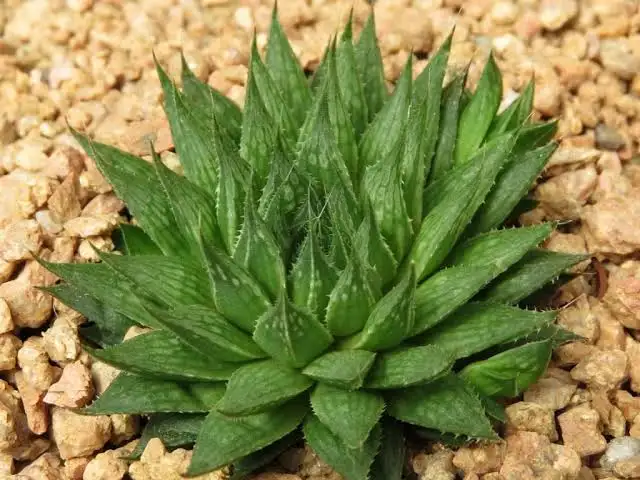
Haworthia marumiana is a tiny mound-forming succulent in the shape of a solitary rosette, which over time clusters at the base. It has fleshy triangular leaves, of a dark green color with wonderful creamy yellow variegations, covered with irregular white spots that make the plant rough to the touch. Exposed to the intense sun, the epidermis can take on purple hues. The edges of the foliage are covered with small whitish teeth, which give the plant an even wilder appearance. It is a very decorative plant and, thanks to its compact size, it can embellish any corner of your apartments.
Haworthia coarctata
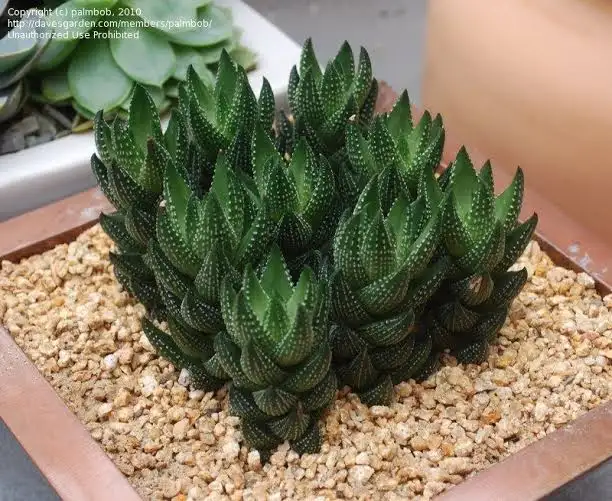
Haworthia coarctata is a succulent plant up to 8 inches (20 cm) tall and it grows in large clumps in its natural habitat, with long stems packed with robust succulent leaves. It is normally dark green but sometimes acquires a rich purple-red when in full sunlight. It is frequently confused with Haworthia reinwardtii. However Haworthia coarctata has smaller, smoother and rounder tubercles on its leaves (those of Haworthia reinwardtii are sometimes larger, flatter and whiter). Haworthia coarctata also usually has much wider, fatter leaves. Anytime from late spring to fall, the largest, most mature rosettes produce up to 12 inches (30 cm) long, whip-like flower stems. Tiny greenish-white, tubular flowers occur on the stems high above the foliage.
Haworthia Longiana

Haworthia Longiana is commonly known as a beautiful looking succulent. Tall stemless grass-like plant that looks like a miniature Agave, slowly forms clumps. It can assume huge proportions by Haworthia standard, but the length and slimness of leaves are quiet variable from plant to plant depending on clone and origin. Some of its forms can be almost unbelievably slow growing, producing no more than one or two leaves a year, and remaining content in a 6 cm. The green fleshy leaves often have reddish ends. When the plant produces flowers expect them to be creamy-white appearing from summer.
Also Read: Saguaro cactus Facts And How To Grow
Haworthia springbokvlakensis

Haworthia springbokvlakensis is a contracted and reduced succulent that grow embedded on shallow soil and in rock crevices scattered on a small hill in the dry interior West Cape around Oudtshoorn where the population density was never very high. In this area the rain is scant but can occur in winter or summer. They grows almost buried with only the upper retuse face of the leaves visible, on a firm hard gravely soil with pH 6,8 in the protection of shrubs often in deep shade and covered with dust.
Haworthia cymbiformis

Haworthia cymbiformis is a stemless evergreen, succulent plant, commonly known by the name Cathedral Window Haworthia. It produces small, succulent leaves reaching up to 5cm long. The leaves are arranged in rosettes and are a pale green colour, with discrete white striated markings on the leaves. Flowering time is from mid spring or early summer. These plants are able to grow relatively fast, with the growth rate greatly influenced by factors such as water availability, supplementary feeding and suitability of the environment.